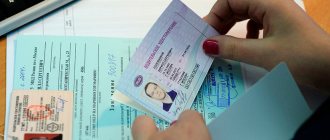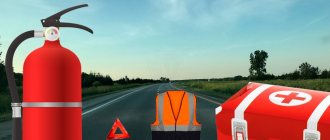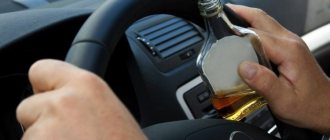Without a driver's license, a person has no right to drive a car; this is punishable by a fine. Before obtaining a license, it is necessary to undergo an examination, a number of doctors will announce their results, and after that it is decided whether the person will receive a license or not.
Particular attention is paid to the visual analyzer. They go to an ophthalmologist to make sure that their eyes are working properly, because with poor vision, the risk of serious road accidents increases.
Reasons why a driver will be denied a license
The presence of these diseases may limit the ability to operate the machine:
- mental disorders,
- symptomatic diseases,
- delusional states,
- schizophrenia,
- oligophrenia,
- bipolar emotional disorder,
- schizoneurosis,
- epileptic seizures,
- deafness,
- serious cardiovascular diseases,
- achromatopsia,
- mental disorder caused by the use of medications.
Completing this list is driver blindness. Additional contraindications include:
- fitishism,
- transsexualism,
- voyeurism,
- pedophilia,
- bi-transsexualism.
Will a driver be issued a license if they have vision problems?
When it becomes possible to improve visual acuity by using one of the traditional techniques, then driving a car is quite acceptable. For example, sometimes it is possible to wear glasses when driving.
There may be disturbances in the functioning of the eyes, but they should not adversely affect the driving process. These changes in the body of many people occur individually. If changes in visual acuity cause a lot of trouble, you should contact an ophthalmologist to select certain means to correct visual acuity.
IMPORTANT !!! Without an ophthalmologist's mark, the driver will not be allowed to drive a car. Some generalists try to learn the letter table by heart. They do not take into account the extensive experience of health workers in identifying such cunning people. Hesitations when naming letters will be a clear signal to the ophthalmologist that the table should be changed and the vision test should be carried out using a different one. Usually the specialist directs the driver’s attention to variations with circles open to one side. It is simply impossible to remember them by heart.
A visit to the ophthalmologist is a very important point in passing the medical examination. Such a check is more necessary for the driver himself than for the health worker, because driving with poor eyesight is quite difficult. Often such driving ends in participation in an accident where people can get hurt.
What vision is allowed for driving?
It is not surprising that during a medical examination, doctors evaluate the operation of the optical apparatus especially carefully.
This is due to the fact that on the road, visual acuity largely determines the driver’s reaction to changing situations and is one of the factors that will allow, if necessary, to prevent a traffic accident. Since there are few people with perfect vision, the question often arises about what deviation in visual acuity is allowed for the driver to be allowed to drive
Visit to an ophthalmologist
To start studying at a driving school, you will have to visit an ophthalmologist. If there are no problems with vision, then the visit to the doctor will not be delayed and the candidate driver will be able to drive a car. The situation is somewhat different if optical correction or other treatment is required to restore visual function. Only an ophthalmologist after a diagnostic examination can give an accurate answer to the question about the acceptability of visual function.
Determination of visual acuity
Studying visual acuity is the simplest and most mandatory diagnostic test, which is performed in the ophthalmologist's office. To diagnose the future driver, they are asked to position themselves at a distance of five meters from a uniformly illuminated special letter table. The study is carried out first on one side, then on the other. The opposite eye is excluded from the act of vision by covering it with a special non-translucent plate or with the palm of the hand. If the subject sees well all the letters located on the tenth line of the table, then his vision is ideal and no glasses correction is required. If a person has difficulty reading the tenth line, then the diagnosis is carried out by reading higher lines. It is important to note that if visual acuity decreases, driving a car is allowed only with the use of specially selected optical correction. When passing the commission, visual acuity is determined already with glasses or contact lenses.
To the question of whether an ophthalmologist will allow you to begin training if a person has chameleon eyes, you can give an affirmative answer. This is due to the fact that the color characteristics of the iris do not in any way affect visual acuity and control ability.
Minimum indicators
In order for a driver candidate to be admitted to training at a driving school, his vision must satisfy a number of minimum parameters:
- For training in category B, a visual acuity of 0.2 is allowed for a visually impaired eye and 0.6 for a healthier eye.
- For category C, these indicators should be slightly higher: 0.4 and 0.8 units, respectively. Another acceptable option is a visual acuity of 0.7 in both eyes.
Even when using optical correction (glasses, contact lenses), there are a number of limitations. The optical power of correction devices should not exceed 8 diopters in both directions. The difference in the power of optical devices in different eyes should not be more than three.
Since there are few people with perfect vision, the question often arises about what deviation in visual acuity is allowed for the driver to be allowed to drive.
Level of color perception
The level of color perception is also based on the doctor, who gives an opinion on the suitability of a driver candidate to drive a car. It is this indicator that determines the quality of color vision, and, accordingly, how correctly the driver will recognize traffic light signals. To determine this indicator, the doctor uses Rabkin tables.
To obtain a driver's license, you can only have a type A anomaly. This condition is accompanied by a slight impairment of color vision and does not interfere with the recognition of traffic lights. It is important to say that this indicator cannot be corrected, so such patients cannot drive a car or other vehicles.
Horizon
Limitation of visual fields greatly affects the ability to drive a car. More often, this condition is not an independent sign, but a symptom of some eye disease. In order to obtain a license, you must have a vision of at least 20 degrees. It is not possible to correct the narrowing of the visual field with the help of contact lenses or glasses, therefore, if the visual field is limited to more than 20 degrees, a person is not allowed to drive.
Eye diseases
Some pathological changes in the organs of the optical apparatus are also a contraindication to driving. The most common such diseases are cataracts, retinal detachment, and glaucoma. However, the final decision remains with the ophthalmologist from the commission. His decision is based on the severity of the disease and the data obtained during the examination.
From the article you can understand that not all people may be allowed to drive. In this regard, some patients try to outwit the doctor or obtain a certificate illegally. It is important to understand that in this case you create a danger not only for others, but also for yourself. That is why you should not neglect a full examination. It would be correct to perceive a medical examination as a mandatory step on the path to obtaining a driver's license.
Share
- Interesting
Central vision
Central vision is the area of clear vision located in the central part. It is this that determines visual acuity and is...
What are the requirements?
If a motorist uses glasses while driving, they must be taken with him to the doctor. Diagnosis of visual acuity indicators is carried out using tables with letter images. Each category will have specific requirements. To become the owner of a category “B” document, vision of at least 0.8 diopters is required. The second organ may have 0.4 diopters.
Subcategory “C” will require the motorist to have an acuity of one of the visual organs of 0.7. However, both eyes do not always have the same visual acuity. The maximum seeing organ should have indicators above 0.6, and the visually impaired organ should have indicators above 0.2.
People using lenses must understand that the difference between the indicators must be less than 3 divisions. If a motorist has one eye completely blind, then the indicators of the second visual organ must exceed 0.8 diopters.
What vision can you drive with?
We have already told you that a positive conclusion from an ophthalmologist is required to obtain a license. The doctor checks visual acuity and eye health.
A person with not very good eyesight can obtain a driver's license. The ophthalmologist looks at how he sees with lenses or glasses.
If a driver with a visual impairment fails the test wearing his glasses, the specialist will prescribe him a stronger driving lens.
Visual acuity safe for driving is 0.6 units in one eye and 0.2 units in the other.
Also read: How to pass a medical examination when obtaining a driver's license
Determining the presence of color blindness
The main thing for a motorist is to have not only acute vision, but also the ability to distinguish shades. Otherwise, he may well drive through a red signal instead of a green one. This can create an accident on the roadway. Typically, experts use the Rabkin table to diagnose color blindness.
Color sensitivity can be divided into the following categories:
- trichromancers,
- protanopes,
- deuteranols.
Color blindness is considered an insurmountable barrier to obtaining the coveted certificate. However, if the disease was diagnosed at an early stage, during this period you can obtain a medical certificate giving permission to drive.
Diagnosis is made using images with multi-colored circles. The patient is asked to name the geometric shapes or numbers that he sees. When difficulties arise with this, we can talk about the presence of color blindness. In this case, you can forget about rights.
Colorblindness test
Another study, along with the assessment of visual acuity, is the determination of the driver’s color perception. This criterion is important for establishing a person’s ability to distinguish colors, which plays a significant role on the roads, in particular, when recognizing markings and road signs.
Please note! Color perception involves establishing the presence or absence of color blindness in a person, which is done through a special table of color sensitivity, which involves identifying three groups of patients:
- trichromantics - people without vision problems,
- protanopes - people with disorders in the red spectrum,
- Deuteronopes are people with sensory disturbances in the green color spectrum.
According to the current rules in Russia, citizens suffering from color blindness are not issued a driver's license. To determine the possibility of obtaining a license, you will need to pass a test with multi-colored figures.
When is driving for visual reasons prohibited?
They may legally refuse to issue motorists with a license for a tractor, “C”, “D”, “D1” or other types if they have these diseases:
- disorders of the lining of the eye organ in the chronic stage,
- limitation of the width of the radius of vision by 20 degrees,
- inflammation of the lacrimal sac that does not respond to traditional treatment,
- color vision impairment,
- diplopia accompanied by strabismus,
- retinal disinsertion,
- decreased night vision,
- glaucoma,
- damage to areas of the retina or optic nerve.
Appearance of the GCL identifier in the certificate
From 2014, drivers will be required to issue a new type of license, as required by law. In this document, the index identifies new subcategories of auto control. Using these marks, you can determine the presence of restrictions due to health conditions. When a doctor determines that you cannot drive a car without glasses or lenses, a GCL mark is placed on your license. To obtain a license, a motorist must be photographed wearing glasses. This will dispel all the inspector’s doubts regarding the safety of the driver’s movement.
Penalty for driving without glasses/lenses in 2021
If there is a note on the driver’s license that he must drive a car with glasses/lenses, but he drives without them, he risks being punished for this.
In 2021, driving without glasses or lenses for people who have evidence for this is punishable by a fine of 5 to 15 thousand rubles. Driving without corrective vision aids is regarded as driving without a license.
Interesting fact: there is no article in the legislation of the Russian Federation that talks about driving without glasses . Therefore, for such a violation, drivers are treated as responsible for driving without a license. That's why there are such large sums for driving without glasses.
But keep in mind that if an employee of the State Traffic Inspectorate reveals a violation and catches the driver for driving without glasses, he will incur additional costs. After all, his car will be taken to the impound lot.
In the future, he will have to pay money for the towing of the vehicle and its storage until the violation is eliminated.
In some cases, a fine can be avoided if the driver proves to the inspector that he did not have time to put on his glasses, but they are lying next to him.
Imperfect vision is not always a stumbling block for drivers who want to get a license. To the question of many forum members: “What line do you need to see in order to smoothly obtain access to your license?” The answer is clear: “The very bottom.”
But even if your vision is blurry, you can get admission, because no one has canceled contact lenses and glasses.
Remember that driving without corrective aids increases the danger on the road . Therefore, think about other people, be sure to wear glasses/lenses to not only avoid a fine, but also traffic accidents.
What awaits a motorist driving without glasses?
If a motorist neglects the recommendations of doctors and drives a car without using devices such as glasses or lenses, then in the eyes of representatives of the law he acts as an offender. If there is a sign saying “Goggles are required”, driving without them is prohibited. For this offense, the driver faces a penalty of up to 15,000 rubles.
ATTENTION !!! The severity of the penalty is due to the fact that traffic cops equate the offense to driving without a license, since a license without glasses is invalid.
Most drivers who have forgotten their glasses at home try to convince the inspector of miraculous healing and restoration of vision. Medicine allows for improvement of visual acuity naturally or with the help of surgical intervention, but for the inspector such a statement is not an argument, since the rights with a special mark prescribe something completely different.
Ophthalmologist bans driving
Very often, a doctor simply cannot issue a permit to drive a car. This happens in the following cases:
- the postoperative period is not over yet,
- the presence of significant changes in certain areas of the mucous membrane of the eyes,
- progressive glaucoma,
- optic neuropathy or other diseases.
Sometimes the motorist himself feels the changes that have happened to him recently. To make movement more comfortable, you should visit an ophthalmologist yourself. If the doctor selects the optical devices correctly, the driver can continue driving on completely legal grounds. With the help of glasses or lenses, he will be able to eliminate the lack of visual acuity. Incorrectly selected corrective agents can be the reason for denial of permission to drive, so this issue should not be joked about.
IMPORTANT !!! Sometimes the doctor may recommend that the patient undergo a course of visual stimulation. Often, such procedures help solve the problem of reduced eye sharpness. Before visiting this specialist, you should reduce physical activity and try to completely abstain from alcoholic beverages.
When an ophthalmologist does not allow a driver to drive a car, but the driver’s vision is fine, he can always appeal the doctor’s decision to the appropriate authority.
Sivtsev tables
Sivtsev’s table for checking vision is the name of the poster with letters, which is in every ophthalmology office in Russia and the CIS countries.
It is named after the ophthalmologist Dmitry Aleksandrovich Sivtsev. The test table, as you know, is a set of printed characters - letters. There are seven of them in total: B, I, K, M, N, Y, Sh. They are written in twelve lines. From the top line to the bottom the letters decrease.
To the left of the lines is indicated “visus” - a value corresponding to visual acuity. It is denoted by the Latin letter V and is expressed in conventional units. So, the row at the very top corresponds to the indicator 0.1, the bottom - 2.0.
It is considered normal if a person reads what is written on the tenth line from five meters away
It is considered normal if a person reads what is written on the tenth line from five meters away. Then V=1.0 (corresponds to 100% vision). Scientists have found that such a person visually separates neighboring points when the angular distance between them is 1/60 of a degree, or 1 arc minute. At a distance of 5 m it is 1.45 mm. This distance separates two adjacent vertical segments in the letter Ш from the tenth line.
How is the check carried out?
A vision test carried out using the Sivtsev table is called visometry. The test canvas is illuminated by two fluorescent (daylight) lamps so that the illumination is 700 lux. The lower edge of the lighting fixture is at a height of 120 cm from the floor surface.
They check the eyes one by one, first the right, then the left. The eye being tested is open, the other is covered with a special shutter, but the eyelids of both eyes are open, and the head is held strictly straight. The lines after the tenth are for people with vision levels of 150 and 200%. Also, these lines can be used when the length of the cabinet is not enough to conduct research from 5 m. Amendments are made to the calculations accordingly.
Visual acuity is defined as:
- complete, when a person correctly named all the letters in a row without exception;
- incomplete (for the corresponding series), when errors are made, and their number is limited.
| Line number | Number of mistakes |
| 1-3 | |
| 4-6 | 1 |
| 7-10 | 2 |
When the result obtained is below 1.0, we talk about myopia (myopia), above 1.0 - about farsightedness (hypermetropia).
If, during the test, a person is not able to read what is written in the top row, he is asked to move half a meter closer to the table. This is done until the person being tested correctly names all or most of the letters. Then visual acuity is calculated using a special formula: V = d / D. Here d is the distance from which the test is performed, and D is the distance from which the line is seen with normal vision (100%, or 1.0) (this is a constant it is indicated to the left of the rows, its indicators are from 50 to 2.5). So, if, according to the formula, we multiply the standard 5 m for such a check by the visa indicator 0.1 of the first line, it turns out that a person can see the largest figures in the table from a distance of 50 m, the last one - from 2.5 m. However, if a person does not sees the characters of the first row, prefers the Pole's optotypes.
Watch the video on how to check visual acuity using the Sivtsev table:
What can trigger a court order to deprive of rights?
When a driver is diagnosed with a disease that interferes with driving, many motorists are interested in the question of what restrictions may be imposed. If suspicions arise, the prosecutor's office sends a request to the hospital about the state of health of the person being examined. The information received will be verified with the traffic police database. If the driver has medical contraindications that limit his ability to drive, the prosecutor's office sends the case to court. When the courts make a decision not in favor of the driver, he may be deprived of his license forever or until he recovers.
conclusions
The safety of using a car directly depends on the health of the driver’s eyes. At the same time, everyone, even very young Russians, has been tested at least once by an ophthalmologist. Therefore, the answer to the question of how vision is checked for a driver’s license is no secret to anyone. And only if the result of this procedure is positive, permission to drive a vehicle will be obtained. After all, a driver with poor vision is a direct threat to the safety of all road users.
Changes in legislation
Recently, the requirements for drivers have become significantly stricter. A resolution was submitted for consideration requiring the motorist to carry a medical certificate with him at all times. The list of diseases that prevent a driver from legally accessing a car has been expanded. When undergoing outpatient treatment for a number of diseases, the driver will be temporarily limited in driving. These diseases include influenza or hypertension. The bills have been submitted for consideration, but it is unknown whether they will be adopted this year. There are a number of reasons why implementing this solution is quite problematic.
In order to travel comfortably and safely by car, you should be attentive to your own health and compliance with traffic rules. Only in this case the driver will not have any unpleasant “surprises” on the road.
Vision test for drivers
An appointment with a specialist begins with a conversation. When interviewing the patient about his complaints and medical history, the doctor will clarify information about:
- hereditary ophthalmological diseases;
- illnesses suffered previously;
- presence of allergic reactions;
- medications and eye drops used;
- harmful and dangerous influences during professional activities.
After the conversation, the doctor carries out all the necessary diagnostics. Vision has such characteristics as acuity, color discrimination, eye accuracy, distance and speed estimation, visual field size and gaze movement speed. Taking this into account, when conducting an ophthalmological examination during the driver's commission, the following are checked:
- degree of visual acuity;
- level of color perception;
- width of the field of view.
All indicators must be reliably determined, which will subsequently influence the decision on the possibility of allowing the person being examined to drive.
Driver visual acuity
Visual acuity is the ability of the eyes to distinguish the shape of an object even at a considerable distance. There is a division into central and lateral vision, where the acuity of the former is 4 times higher than the latter.
With normal visual acuity, the driver perfectly perceives the shape of road signs and other road objects. With a pathology such as farsightedness, the driver can clearly see the roadway going into the distance, but cannot clearly see the readings of dial gauges or signal indicator icons on the dashboard. A nearsighted driver, on the other hand, can focus on nearby objects on the dashboard but cannot see the road well. Such conditions cause a number of additional difficulties, such as, for example, poor evening or night vision, as well as severe fatigue and discomfort. This poses a serious danger.
In order to promptly identify deviations below the permissible limits for visual acuity, the ophthalmologist conducts diagnostics using sets of Golovin-Sivtsev tables, which have 12 rows of signs. The letters of the largest size are located on the top line, and the smallest on the bottom line. The subject must recognize letters at a distance of 5 meters. Vision is one hundred percent when a person is able to recognize the tenth line in order with each eye separately.
Level of color perception
Color perception refers to a person's ability to distinguish colors. The driver needs color sensitivity in order not to create emergency situations and to recognize traffic lights, road signs, and light signaling of vehicles involved in traffic.
Color perception testing is carried out according to Rabkin's tables. The test allows you to identify the forms and degrees of color vision impairment using 48 tables on which geometric shapes or numbers are collected from dots of different colors. A person with color blindness will not be able to distinguish between colors and see hidden images. The inability to distinguish colors (color blindness) is an insurmountable obstacle to obtaining a license.
Width of horizons
The field of view or breadth of vision is a certain area of space that can be covered by the human eye. The driver's concentration fields must be wide so that he can see objects and objects not only in the center. If the visible space is less than 20 degrees, it is considered narrow and a person cannot drive a vehicle.











